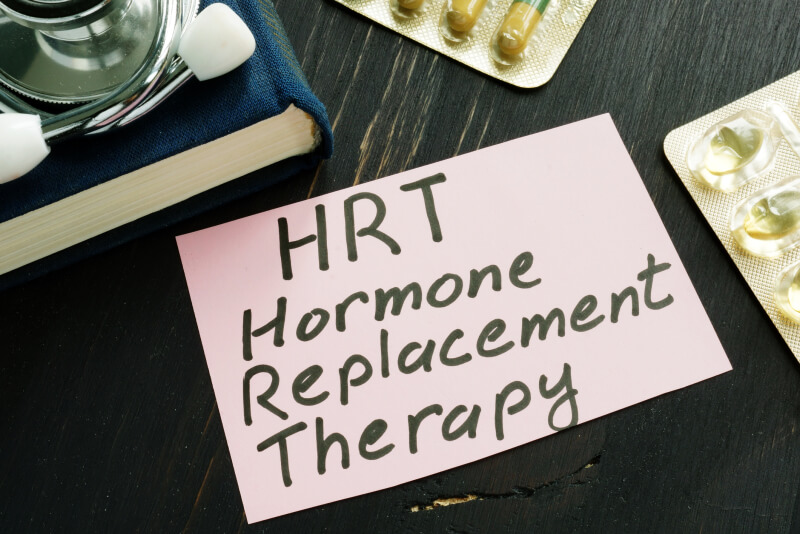
Uterine fibroid, or leiomyoma, is a common condition of the uterus that can occur in at least 50% of women who are of reproductive age. The presence of fibroid is benign and they are usually asymptomatic so not all women may be aware that they have this condition. Hormonal imbalance can affect fibroid growth in women but the good news is that most signs of fibroids are said to improve after menopause.
So how will hormone replacement therapy for menopausal women with history of leiomyoma work, and is it safe to take? Many women take hormone therapy to help with their menopausal symptoms, and those with a history of leiomyoma may safely take HRT to manage severe symptoms of fibroids like abnormal bleeding. There are available low-dose HRT medications and those that can inhibit estrogen production to prevent new growths or shrink the fibroids.
Uterine fibroids, also called uterine myoma or uterine leiomyomata, are noncancerous growths of muscular tumors that form on the walls of the uterus. Often, fibroids can appear as small and tiny as a seedling but in some cases, they can grow unusually large and put pressure on the other body organs and affect the size of the uterus.
Fibroids can be further classified depending on the area where they grow. The common types of fibroid growth are:
Fibroids are a complex medical condition and it is often hard to pinpoint the exact cause of these growths. There are certain risk factors that are said to contribute to the development of fibroids such as age, genetics, family history, obesity, and high blood pressure.
There are few cases of fibroids that come with symptoms, and it is usually affected by the size and location of the growth. The common signs of uterine fibroids in a perimenopausal or postmenopausal woman are:
Fibroid symptoms can be similar to other medical conditions that can affect a woman’s reproductive organs such as ovarian cyst (fluid-filled sacs in the ovary) and endometrial polyp (tissue growths). In some cases, the growth of fibroids may attach themselves to the uterine lining and affect the endometrial thickness, resulting in endometrial hyperplasia.
Most of women’s reproductive organs and functions are influenced by the presence of estrogen and progesterone. These female hormones affect the lining of the uterus and uterine fibroids, which grow on the walls of the uterus, are also believed to be caused by these two hormones.
There are studies that show how fibroids are hormone-sensitive growths in the uterus. For one, women who are pregnant usually have high hormone levels. The estrogen and progesterone during pregnancy prepare the uterus to be a suitable environment for the developing baby. In the same way, this increase in hormones can affect the size and growth of uterine fibroids.
Leiomyomas can also develop or worsen their symptoms every menstrual cycle where estrogen levels tend to fluctuate. Most experiences of painful periods or menstrual cramps can be attributed to the presence of uterine fibroids. However, many doctors believe that fibroids can improve once a woman reaches menopause.
Menopause is a normal life stage where a woman stops having her period. During this transition, it’s common to have hormonal imbalance since the body experiences significant drops in the female hormone levels.
Women approaching menopause may experience worsening symptoms of fibroids for a period of time. But after menopause, the chances of developing new fibroids are low since the decrease in estrogen levels is not enough to support its growth. Some doctors also say that fibroids can shrink in size during the menopause or postmenopause stage.

Hormone replacement therapy has long been used by many women for relieving common menopausal symptoms such as vaginal dryness, hot flashes, night sweats, irritability, sudden mood swings, aches and joint pains, and menopausal hair loss.
It is a treatment that is known to significantly improve the quality of life for many older women who are menopausal or postmenopausal. In fact, HRT can also lessen the risk of chronic conditions that can affect postmenopausal women such as osteoporosis, colorectal cancer, and even diabetes.
Hormone replacement therapy is a treatment that allows women to replace the essential hormones that their body stops producing at menopause. Women who have had undergone a hysterectomy to remove their ovaries are also given hormone therapy to alleviate symptoms of early menopause.
Hormone therapy medications are available in a variety of forms and deciding on which HRT type to take will depend on the doctor’s recommendation, your preferences, and your current condition. Generally, HRT can be classified into different kinds according to what hormone type is given:
Hormone therapy can also be considered as an effective treatment for uterine fibroids. However, when choosing the right medication, menopausal patients with a history of leiomyoma should avoid taking pure estrogen therapy alone. As much as possible, the doses of hormones in HRT medications for patients with leiomyoma should be low to avoid complications with the fibroids.
The types of hormone treatments that can help with uterine fibroids are hormonal agents, progestin-releasing intrauterine devices, contraceptives or birth control pills, and GnRh agonists. These hormone medications can relieve discomfort from fibroid symptoms and may help shrink their size by preventing the effects of estrogen and progesterone.
Hormonal medications include selective progesterone receptor modulator (SPRMs) drugs such as medroxyprogesterone, mifepristone, and androgen drugs like Danazol can be prescribed to treat abnormal bleeding or heavy menstrual periods. These medications can work to block the activity of progesterone and control the growth of fibroids.
Intrauterine devices are a type of contraception device that is directly inserted into the womb or uterus. These usually contain progestin which is the synthesized and artificial form of progesterone hormone. When placed in the uterine cavity, the device will continuously release progestins that can prevent the uterine lining from building up and reduces uncontrollable heavy bleeding induced by fibroids.
Using intrauterine devices can cause certain side effects such as breast swelling or tenderness, acne, spotting between periods, headaches, nausea, and skin conditions like acne.
Birth control or oral contraceptive drugs are medications used to prevent possible pregnancies. It works by preventing the ovaries from producing eggs that can be fertilized during ovulation period. Birth control pills may contain both estrogen and progesterone hormones or progesterone alone.
While it primarily serves to control pregnancies, women with heavy flow of blood during menstrual cycles may also take these contraceptives to reduce the heavy bleeding. They may not have a direct effect on shrinking fibroids but they can provide short-term relief from its unpleasant symptoms.
The common effects of taking birth control pills are headaches, nausea, fluid retention, weight gain, and high blood pressure. These drugs may also increase risk of blood clot or deep vein thrombosis in older women. In some cases, taking contraceptives may increase the size of uterine leiomyoma so patients are usually advised to discontinue the medications and see a doctor if this happens.
Gonadotropin-releasing hormones, also known as GnRh agonists, are medications that can impede with the production of estrogen hormone in the ovaries. Since estrogen can influence the development of uterine leiomyoma, taking GnRh agonists can temporarily block the activity of estrogen which in turn can help reduce the size of the fibroids.
One of the common drugs in the GnRH agonist family is leuprolide (Lupron). This is usually administered via injections and it is prescribed for women who have serious heavy and abnormal uterine bleeding every menstrual period. Long term use of these medications is usually not recommended because of its side effects. It can cause severe menopausal symptoms such as hot flushes, night sweating, vaginal dryness, and may increase chances for bone loss or osteoporosis.
These medications can help decrease the growth of the symptomatic fibroids before undergoing surgery. Stopping GnRh agonists will trigger the uterine leiomyomata to grow back and return to their original size. If you’re taking these medications, it’s best to have regular check-ups and exams with a doctor to see if your fibroid condition worsens.
Hormone therapy is a safe treatment as long as it is regulated and taken under a doctor’s advice. Menopausal women with history of leiomyoma can safely receive HRT and benefit from its effects since there are available medications with low concentrations of estrogen and progestin and those that can suppress its effects.
However, there are certain cancer risks that come with taking long-term HRT. Women who take estrogen therapy for prolonged periods may have increased endometrial cancer risk, breast cancer, cardiovascular disease, and ovarian cancer. While in some women, combination therapy may reduce the risk for endometrial cancer and colon cancer.
To be on the safe side, taking HRT for treatment and relief of menopause symptoms should only be taken for two to three years. If you’re prescribed with HRT and you have fibroids, you will need to have regular examinations to see how your fibroids are responding to the hormone treatment.
When you decide to quit hormone therapy, you need to discuss with your healthcare provider about lowering the dose before completely stopping the medications. This is done to help the body adjust to the low levels of hormones and stop depending on the medications.

Uterine fibroids are commonly diagnosed during a pelvic exam where a doctor will examine for any abnormalities inside the uterus. An endometrial biopsy or hysteroscopy may also be performed to confirm any cancerous growths and take out the fibroids.
Most of the time, surgery for uterine fibroids are considered for severe cases that don’t respond to medications. Here are the possible medical procedures for uterine leiomyomata:
For myoma that causes abnormal uterine bleeding, an endometrial ablation may be performed to reduce its symptoms. During this procedure, a surgeon will remove or destroy the uterine lining to stop the bleeding. It usually uses radiofrequency energy to damage both the lining and shrink the fibroids. However, there are some doctors that may use the cryomyolysis technique to freeze the fibroids instead of heating them.
This procedure is usually assisted with a laparoscopic ultrasound tool to help locate the fibroids. Once the fibroids have been detected, another device will insert tiny needles that will emit the radiofrequency waves to destroy the myoma. It’s still considered a minimally invasive treatment since it doesn’t require any large incisions and recovery will only take a few days.
A myomectomy surgery removes the fibroids while keeping the uterus intact. This is an ideal option for younger women who want to improve their symptoms but still want to have children in the future. There are different approaches to performing a myomectomy:
Another major surgical procedure to remove the fibroids is a hysterectomy. During this procedure, the whole uterus is removed and this makes sure that the fibroids are gone for good. One downside to this operation is that a woman can no longer try to get pregnant. For menopausal women, the ovaries may also be removed during the hysterectomy to stop menopause symptoms.
Depending the size of the uterus, the procedure may be performed via taking out the uterus from the vagina (vaginal hysterectomy), through an incision on the lower abdomen (abdominal hysterectomy), or laparoscopically. Generally, women with a large uterus are not be eligible for the laparoscopic approach.
This procedure is also known as uterine fibroid embolization. This technique completely hinders the flow of blood to the fibroids, stopping their development and eventually causing them to decrease in size.
This is usually done in a radiology room rather than an operating room since it’s less invasive compared to the myomectomy and hysterectomy. This treatment only needs injections of small particles called polyvinyl alcohol into the arteries that supply the fibroid. The injected substance will block the blood supply so that the fibroids will stop growing.
Menopause and fibroids are two common occurrences for a woman. In fact, they may go hand-in-hand since fibroid growth becomes more prevalent as you near the menopause stage. And while most fibroids are not dangerous, it doesn’t mean that you have to endure the discomfort from its symptoms.
Get safe and effective hormone replacement therapies to help with your menopause and fibroids symptoms at Revitalize You MD. We are committed to helping you achieve overall health and wellness by restoring the balance to your hormones. Consult with us today and receive a personalized HRT plan for your needs.
The staff is great, the products work!! I am very pleased with my results!